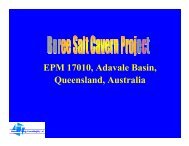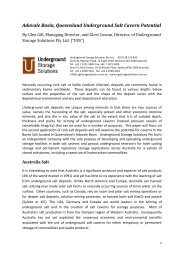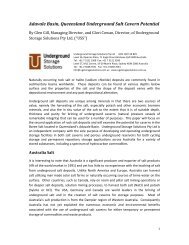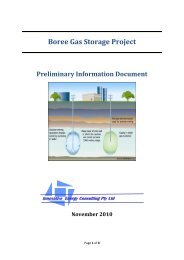Natural gas storage in salt caverns present trends in Europe
Natural gas storage in salt caverns present trends in Europe
Natural gas storage in salt caverns present trends in Europe
Create successful ePaper yourself
Turn your PDF publications into a flip-book with our unique Google optimized e-Paper software.
GILLHAUS, A. (2007): <strong>Natural</strong> <strong>gas</strong> <strong>storage</strong> <strong>in</strong> <strong>salt</strong> <strong>caverns</strong> – Present status, developments and future <strong>trends</strong> <strong>in</strong> <strong>Europe</strong><br />
The high quality Zechste<strong>in</strong> <strong>salt</strong> deposits (Upper Permian) <strong>in</strong> the Central <strong>Europe</strong>an bas<strong>in</strong><br />
systems usually have very favourable properties for <strong>gas</strong> cavern construction because of<br />
their large thickness and their high proportion of halite (> 90 vol.-%). The follow<strong>in</strong>g are<br />
found at suitable depths <strong>in</strong> the German Zechste<strong>in</strong> <strong>salt</strong> sequence<br />
• The widespread occurrence of bedded <strong>salt</strong> with thicknesses exceed<strong>in</strong>g several<br />
100 m<br />
• More than 200 <strong>salt</strong> domes with <strong>salt</strong> thicknesses of more than 1000 m <strong>in</strong> part<br />
In the <strong>salt</strong> domes <strong>in</strong> particular, it is important to f<strong>in</strong>d solution-m<strong>in</strong>able <strong>salt</strong> with the lowest<br />
possible number of <strong>in</strong>terbeds of easily soluble potash <strong>salt</strong>s with<strong>in</strong> the ideal depth <strong>in</strong>terval<br />
of 900 to 1700 m. Poorly soluble <strong>in</strong>terbeds (anhydrite, claystone) occur very rarely <strong>in</strong> the<br />
<strong>salt</strong> domes which are therefore highly suitable for the construction of cavern <strong>storage</strong>s.<br />
Other <strong>salt</strong> domes conta<strong>in</strong><strong>in</strong>g high quality Zechste<strong>in</strong> <strong>salt</strong> sequences at suitable depths are<br />
found <strong>in</strong> the north-eastern Netherlands (14 <strong>salt</strong> domes), north-western Denmark (16 <strong>salt</strong><br />
domes) and Central Poland (10 <strong>salt</strong> domes). The Zechste<strong>in</strong> bedded <strong>salt</strong>s <strong>in</strong> these<br />
countries tend to lie at excessive depths too deep for the construction of <strong>gas</strong> cavern<br />
<strong>storage</strong>s. The geological/geotechnical potential for <strong>gas</strong> cavern projects <strong>in</strong> these countries<br />
therefore considerably exceeds demand.<br />
The UK’s position at the edge of the Zechste<strong>in</strong> Bas<strong>in</strong> means that the sequences of pure<br />
Zechste<strong>in</strong> <strong>salt</strong>s are much th<strong>in</strong>ner than on the Cont<strong>in</strong>ent. The depths at the localities used<br />
so far for the construction of <strong>storage</strong>s also tend to be deeper than 1700 m (Zechste<strong>in</strong> 2) or<br />
shallower than 500 m (Zechste<strong>in</strong> 3). The ratio of technical/f<strong>in</strong>ancial costs to the capacity of<br />
the <strong>storage</strong>s is therefore much more unfavourable than most of the other <strong>gas</strong> cavern fields<br />
constructed <strong>in</strong> Zechste<strong>in</strong> <strong>salt</strong>.<br />
Other <strong>gas</strong> cavern <strong>storage</strong>s are successfully operated <strong>in</strong> Mesozoic <strong>salt</strong> (UK, Portugal) and<br />
Tertiary <strong>salt</strong> (France)<br />
Bedded <strong>salt</strong> of Keuper age (Lower Triassic) is used for <strong>gas</strong> <strong>storage</strong> at two localities <strong>in</strong> the<br />
western UK. They lie at depths of less than 700 m and have a high proportion of<br />
<strong>in</strong>solubles (claystone). These non-<strong>salt</strong> layers can be up to 10 m thick and therefore h<strong>in</strong>der<br />
the solution m<strong>in</strong><strong>in</strong>g process and restrict the volume of the <strong>caverns</strong>. It is also much more<br />
complicated to confirm the <strong>in</strong>tegrity of <strong>caverns</strong> built <strong>in</strong> such unfavourable <strong>salt</strong> formations.<br />
Nevertheless, the technical and economic feasibility has already been proven for several<br />
sites and the construction and plann<strong>in</strong>g of other <strong>gas</strong> <strong>storage</strong> projects <strong>in</strong> these formations<br />
are thus under way.<br />
Keuper <strong>salt</strong>s of similar quality are used <strong>in</strong> the rest of <strong>Europe</strong> for br<strong>in</strong>e production at<br />
various localities (Fig. 4). The Keuper <strong>salt</strong>s are found as bedded <strong>salt</strong>, <strong>salt</strong> breccias or <strong>salt</strong><br />
page 9 of 18










